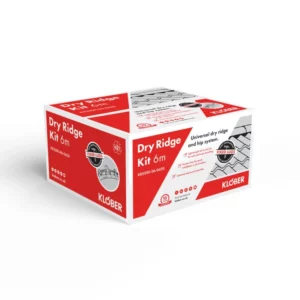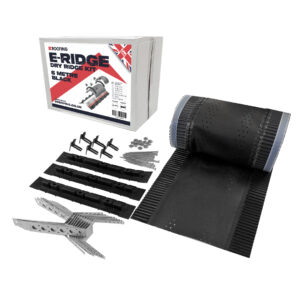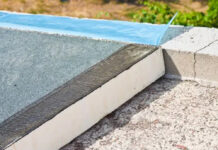For many years the ridges, verges and hips of tiled roofs were fixed in place with mortar. These parts of the roof are some of the most exposed to wind on a roof, and they need to be secured. However, this “wet fix” solution is highly flawed. Mortar is highly porous which makes it vulnerable to weathering. Even worse, as mortar weathers it gets exponentially more fragile, meaning it becomes chronically more expensive to maintain. In addition, mortar fixes the tiles in place very rigidly, making them unable to flex in the face of the wind and increasing the amount of wind damage the individual tiles take.
However, dry fix solves these issues. Dry fix refers to using screws and waterproof unions to fix ridge, hip and verge tiles directly to a roof without need for mortar. It gives the tiles a little bit of give which lets them absorb the impact from the weather much easier, and it eliminates the need for mortar to hold them in place. Dry fix is strongly encouraged on all new builds by modern building codes as a result. But even existing roofs can benefit from dry fix.
What are ridges, hips and verges?
If you’re unfamiliar with the anatomy of a pitched roof, a ridge refers to the apex of a roof where the sides of a pitched roof meet. Hips refers to where the sides meet at a corner of a roof, and verges refer to the edge of a roof hanging over the gable.
The vast majority of roofs have four corners, and will therefore have either zero, two or four hips and correspondingly four, two or zero verges. That’s the first thing you’ll need to pay attention to when you’re buying your dry fix products.
What sort of dry ridge do you need?
Every pitched roof will need dry ridge. Most dry ridge kits nowadays are universal and designed to work with both clay and concrete tile roofs. For clay ridge, a conversion kit may be required. However, some parts of the installation process may differ between them. For instance, clay ridges might not need as many battens as concrete ridges, and might require a different type of end ridge tile.
Make sure you buy enough dry ridge kits to cover your entire ridge. You will need to measure it, or have it measured if you’re not comfortable working on roofs. Most kits come in 6 metre lengths.
What sort of dry hip system do you need?
If your roof doesn’t have any hips you won’t need a dry hip at all. But if you do, it’s very similar to dry ridge. You need to make sure you have enough roll for the whole lengths of each of your hips, as well as making sure that you have the necessary kit or conversion kit for clay if your roof is clay tiles, and concrete otherwise.
You will also have to worry about making sure that all three tiles where two hips meet a ridge are all mitred so they connect without leaving gaps. Usually this is done with an angle grinder to make sure that the tiles fit correctly, and then using a roof sealant afterwards to make sure the joins are watertight.
What sort of dry verge do you need?
As with dry hips, you will only need to use a dry verge if your house has verges. Most verge caps work regardless of your tile type, and instead of directly measuring you will need only count the courses of tiles on your roof to know how many verge caps you need. Some types of verge can only be used on the right or left side of your roof, and some are universal, so keep this in mind when purchasing them.
At the top where the two verges meet they are joined to the ridge by an endcap, so keep this in mind as well, along with the starter kits that form the bottom of the verge. Make sure you get all your caps in the colour that best matches your tiles.








